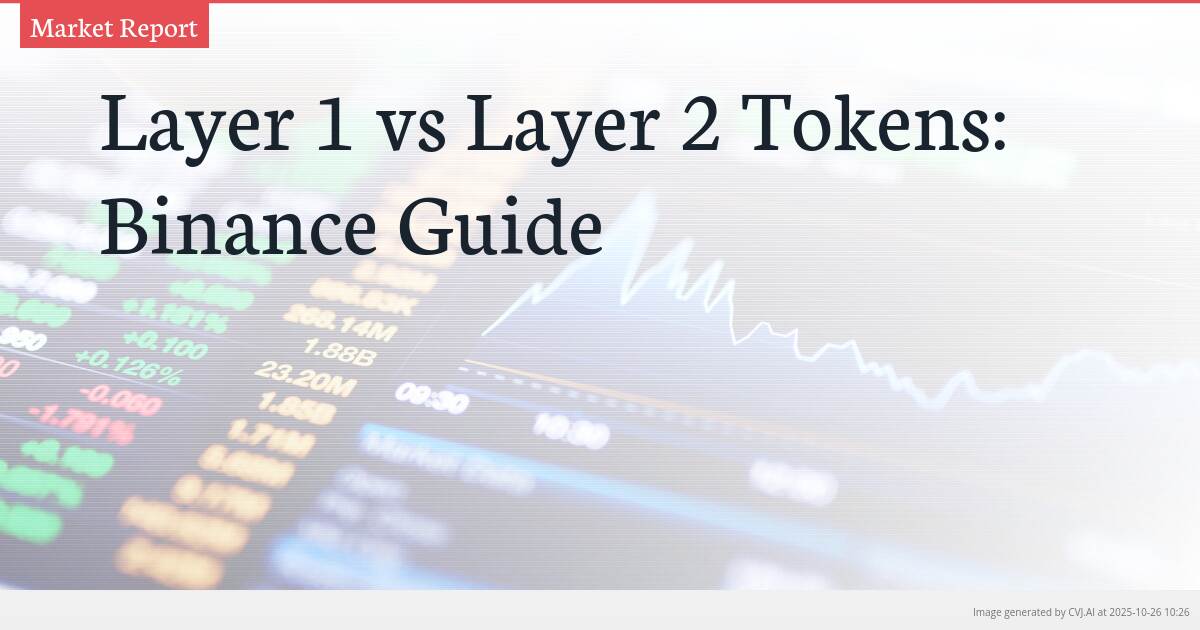This summary text is fully AI-generated and may therefore contain errors or be incomplete.
Introduction
Binance stands out among cryptocurrency exchanges by supporting both Layer 1 and Layer 2 tokens, offering traders diverse blockchain infrastructure options. Understanding the difference between these token types is crucial for navigating the evolving crypto landscape. This guide breaks down their distinct characteristics and popular examples available on Binance, highlighting the fundamental trade-offs between security, decentralization, and scalability that define these two categories of digital assets.
Key Points
- Layer 1 tokens are native blockchain assets (BNB, ETH, AVAX) that provide network security through consensus mechanisms but face scalability limitations
- Layer 2 tokens (MATIC, LRC, ONE) use scaling solutions like zk-rollups and sharding to improve transaction efficiency while relying on Layer 1 for security
- Binance supports both token types, allowing traders to access different blockchain infrastructure options with varying security, decentralization, and scalability trade-offs
Understanding Layer 1 Tokens: The Foundation of Blockchain Networks
Layer 1 tokens represent the foundational infrastructure of blockchain ecosystems, serving as native assets that power every service within their respective networks. These protocol tokens, also known as base layer tokens, are integral to the operation and security of their blockchains through built-in consensus mechanisms. On Binance, prominent examples include BNB, the native token of Binance Chain and Binance Smart Chain; ETH, which fuels the Ethereum network; and AVAX, the core token of the Avalanche ecosystem.
The primary strength of Layer 1 tokens lies in their security and decentralization. BNB enables users to pay transaction fees, participate in staking, engage in governance decisions, and access various decentralized applications (DApps) within the Binance ecosystem. Similarly, ETH serves as the lifeblood of Ethereum, covering gas fees for smart contract interactions and supporting the extensive DeFi and NFT projects built on the network. AVAX performs comparable functions within the Avalanche environment, facilitating fee payments, staking opportunities, and governance participation.
However, Layer 1 tokens face significant scalability challenges due to their limited transaction processing capacity. The very consensus mechanisms that provide security and decentralization—such as proof-of-work or proof-of-stake—create bottlenecks that restrict the number of transactions these networks can handle per second. This fundamental limitation has driven the development of Layer 2 solutions that build upon these foundational networks while addressing their performance constraints.
Layer 2 Tokens: Scaling Solutions for Enhanced Efficiency
Layer 2 tokens represent innovative scaling solutions built atop existing Layer 1 blockchains, designed to improve transaction performance and efficiency while relying on the underlying network for final transaction settlement. These second layer tokens employ various technical approaches to offload transactions from the main chain, enabling faster processing times and reduced costs. Binance features several prominent Layer 2 tokens, including MATIC for the Polygon network, LRC for Loopring, and ONE for Harmony.
MATIC serves as the native token for Polygon, a Layer 2 solution that connects sidechains and bridges with Ethereum and other blockchains. Users leverage MATIC for paying fees, staking, governance participation, and accessing DApps within the Polygon ecosystem. LRC powers the Loopring network, which utilizes zk-rollups technology to enable fast and cost-effective transactions on Ethereum. Similarly, ONE functions as the native token for Harmony, employing sharding and cross-chain bridges to connect Ethereum with other blockchain networks.
The key advantage of Layer 2 tokens lies in their superior scalability and efficiency compared to their Layer 1 counterparts. By processing transactions off-chain or through optimized protocols, these solutions dramatically increase transaction throughput while reducing costs. However, this enhanced performance comes with trade-offs, as Layer 2 tokens face security and compatibility challenges due to their dependence on Layer 1 blockchains for transaction security and interoperability with other networks.
Strategic Considerations for Binance Traders
For cryptocurrency traders on Binance, understanding the distinction between Layer 1 and Layer 2 tokens is essential for making informed investment decisions. Layer 1 tokens like BNB, ETH, and AVAX offer the security and decentralization benefits of foundational blockchain infrastructure, making them suitable for investors prioritizing network security and long-term ecosystem development. These tokens typically serve as the bedrock upon which entire decentralized ecosystems are built, with their value closely tied to the adoption and utility of their respective networks.
Layer 2 tokens such as MATIC, LRC, and ONE present opportunities centered around scalability and efficiency improvements. Investors interested in these tokens are typically betting on the success of specific scaling solutions and their ability to address the transaction limitations of major Layer 1 networks. The performance of Layer 2 tokens often correlates with their adoption by developers and users seeking cheaper, faster alternatives to conducting transactions directly on Layer 1 blockchains.
Binance’s support for both token categories provides traders with comprehensive access to the evolving blockchain infrastructure landscape. The exchange enables users to navigate the trade-offs between security, decentralization, and scalability that define these two token types. As the cryptocurrency ecosystem continues to mature, the complementary relationship between Layer 1 and Layer 2 solutions becomes increasingly important, with each playing distinct but interconnected roles in the broader blockchain architecture available through platforms like Binance.
📎 Read the original article on coincodecap.com

